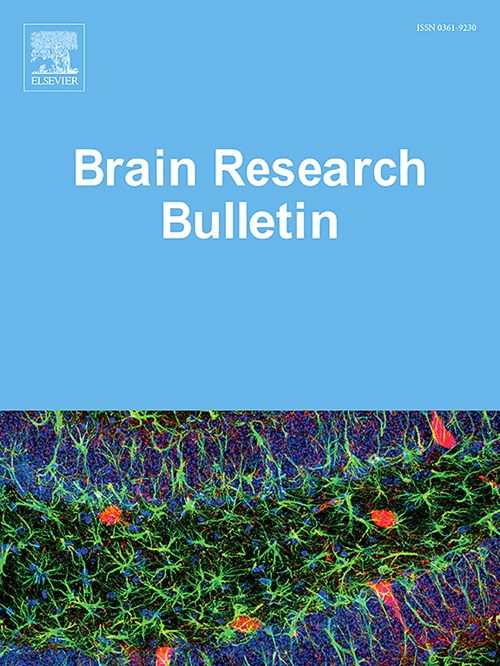槟油碱通过激活AMPK/CREB/BDNF信号通路缓解丙戊酸小鼠模型中自闭症谱系障碍样行为和认知障碍
IF 3.5
3区 医学
Q2 NEUROSCIENCES
引用次数: 0
摘要
对人类的研究表明,自闭症谱系障碍(ASD)的发病机制与白质异常有关,包括髓鞘发育低下和少突胶质细胞功能障碍;然而,有效的治疗方法仍然有限。同样,被广泛用于研究ASD的丙戊酸(VPA)模型小鼠也表现出白质异常,伴髓鞘化降低。槟榔碱有增强记忆和认知、促进髓鞘形成和改善神经功能的作用。本研究探讨槟榔碱在产前vpa诱导的ASD小鼠模型中的治疗潜力。我们通过产前暴露VPA建立ASD小鼠模型,并给予槟榔碱治疗4周。行为学分析包括高架迷宫、开阔场地、自我梳理、大理石掩埋、三室迷宫、y迷宫和Morris水迷宫测试,以评估槟榔碱对行为的影响。采用Western blotting检测槟榔碱处理后额叶皮层蛋白表达的变化。结果显示,在产前暴露于VPA的后代表现出特征性的行为异常,包括重复和刻板行为增加,社会交往缺陷,学习和记忆障碍,并伴有额叶皮层髓磷脂标志物MBP和成熟少突胶质细胞标志物GST-pi的表达减少。4周槟榔碱治疗(1和2mg/kg/天)显著改善了这些行为和认知异常,并恢复了髓鞘标志物。进一步的机制研究表明槟榔碱提高了额叶皮层AMPKα和CREB的磷酸化水平。这种激活上调了下游BDNF的表达,BDNF是少突胶质细胞成熟和髓鞘再生的必要神经营养因子。这些发现表明AMPK/CREB/BDNF通路可能有助于槟油碱的治疗作用,可能通过增加少突胶质细胞成熟和髓鞘再生。这项研究提供了临床前证据,支持槟榔碱作为一种潜在的髓鞘靶向干预手段,对ASD和其他涉及髓鞘缺陷的神经系统疾病具有指导意义。本文章由计算机程序翻译,如有差异,请以英文原文为准。
Arecoline alleviates autism spectrum disorder-like behaviors and cognition disorders in a valproic acid mouse model by activating the AMPK/CREB/BDNF signaling pathway
Studies in humans have revealed that the pathogenesis of autism spectrum disorder (ASD) is linked to white matter abnormalities involving hypomyelination and oligodendroglia dysfunction; however, effective treatments remain limited. Similarly, the valproic acid (VPA) model mice, which are widely used to study ASD, also exhibit white matter abnormalities with hypomyelination. Arecoline has been reported to enhance memory and cognition, facilitate myelination and improve neurological function. This study investigated the therapeutic potential of arecoline in a mouse model of prenatal VPA-induced ASD. We established an ASD mouse model through prenatal exposure to VPA and treated the mice with arecoline for 4 weeks. Behavioral analyses, including the elevated-plus maze, open field, self-grooming, marble-burying, three-chamber, Y-maze, and Morris water maze tests, were conducted to assess the effects of arecoline on behavior. Western blotting was used to detect changes in protein expression in the frontal cortex after arecoline treatment. The results revealed that offspring prenatally exposed to VPA presented characteristic behavioral abnormalities, including increased repetitive and stereotyped behaviors, deficits in social interaction, and impairments in learning and memory, accompanied by reduced expression of the myelin marker MBP and the mature oligodendrocyte marker GST-pi in the frontal cortex. Four-week arecoline treatment (1 and 2 mg/kg/day) significantly ameliorated these behavioral and cognitive abnormalities and restored myelination markers. Further mechanistic investigations demonstrated that arecoline enhanced the phosphorylation levels of AMPKα and CREB in the frontal cortex. This activation upregulated the expression of downstream BDNF, an essential neurotrophic factor for oligodendrocyte maturation and remyelination. These findings suggest that the AMPK/CREB/BDNF pathway may contribute to the therapeutic effects of arecoline, potentially through increased oligodendrocyte maturation and remyelination. This study provides preclinical evidence supporting arecoline as a potential myelination-targeting intervention, with implications for ASD and other neurological disorders involving myelination deficits.
求助全文
通过发布文献求助,成功后即可免费获取论文全文。
去求助
来源期刊

Brain Research Bulletin
医学-神经科学
CiteScore
6.90
自引率
2.60%
发文量
253
审稿时长
67 days
期刊介绍:
The Brain Research Bulletin (BRB) aims to publish novel work that advances our knowledge of molecular and cellular mechanisms that underlie neural network properties associated with behavior, cognition and other brain functions during neurodevelopment and in the adult. Although clinical research is out of the Journal''s scope, the BRB also aims to publish translation research that provides insight into biological mechanisms and processes associated with neurodegeneration mechanisms, neurological diseases and neuropsychiatric disorders. The Journal is especially interested in research using novel methodologies, such as optogenetics, multielectrode array recordings and life imaging in wild-type and genetically-modified animal models, with the goal to advance our understanding of how neurons, glia and networks function in vivo.
 求助内容:
求助内容: 应助结果提醒方式:
应助结果提醒方式:


